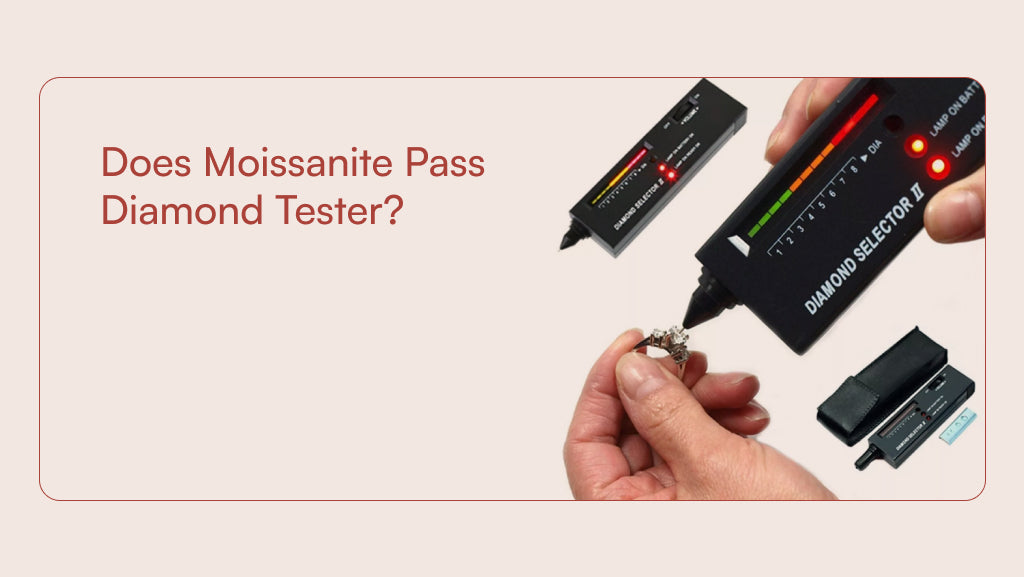Does Moissanite Pass Diamond Tester?
Alex Vora
Moissanite is a gemstone that has gained popularity because of its dazzling and affordable nature as an alternative to diamonds. It was discovered in 1893 by the french chemist Henri Moissan.
This gemstone is made of silicon carbide and is known for its exceptional brilliance and fire. Because of its unique properties, it has become the favorite of many who seek both beauty and value in their jewelry.
Unlike diamonds, which are naturally occurring and come with significant environmental and ethical concerns, most moissanite available today is lab-grown. This process not only ensures high quality but also makes moissanite an ethical and eco-friendly choice for consumers.

Moissanite looks so much like a diamond that many people wonder if it can pass a diamond tester. These are the devices that most commonly identify diamonds due to their ability to detect the thermal conductivity in a diamond.
Moissanite shares some physical properties with a diamond, and it is crucial to know how these testers work and if they can be used to identify the difference between them. This article will explore this answer and provide an all-inclusive guide on how to properly identify moissanite.
Comparing Diamond and Moissanite
Diamonds and moissanite appear rather similar in inspection, but both are actually made of very distinct materials. Diamond is carbon-made and is the Earth's hardest substance.
Moissanite is, on the other hand, manufactured from silicon carbide, almost as hard as a diamond, albeit slightly softer but still incredibly robust. When viewed in terms of brilliance, often moissanites display more fire (those brilliant flashes of colored light) as they have higher refractive index than diamonds. This makes moissanite a dazzling alternative that is often preferred for its sparkle and cost-effectiveness.
Can Moissanite Pass a Diamond Tester?
These measure the thermal conductivity of a gem. Since diamonds possess high thermal conductivity, they have a very quick dissipation rate of heat; hence, any diamond tester is able to spot them. On the other hand, moissanite possesses thermal conductivity properties like diamonds. Hence, in many instances, the tester becomes confused between these two. The moissanite may appear like a diamond with the standard tester, hence potential misidentification may occur.
How Can You Test Moissanite? A Simple Guide
Visual Inspection
A simple visual inspection can reveal some differences between moissanite and diamonds. Moissanite often displays a rainbow-like fire that is more intense than that of diamonds. This is due to its higher refractive index.
Double Refraction
Moissanite exhibits double refraction, meaning light entering the stone is split into two rays, creating a doubled appearance of the facets when viewed through the crown. This property can be observed using a jeweler's loupe and is a key identifier for moissanite.

LED Light Source
Using an LED light source, you can observe the play of light within the gemstone. Moissanite will show more colorful light dispersion compared to diamonds. This method is a quick way to distinguish between the two.
Professional Appraisal
For a definitive identification, professional jewelers use specialized tools such as a loupe to examine the gemstone closely. They look for characteristics like fire, brilliance, facet appearance, and weight. Additionally, a certificate of authenticity, such as one from the Gemological Research Association (GRA), can confirm whether a gemstone is moissanite or diamond.
How Do I Know If My Moissanite Is Real?
To ensure your moissanite is genuine, it is important to purchase from reputable jewelers who provide a certificate of authenticity. A professional appraisal, using specialized tools and techniques, can also confirm the authenticity of the gemstone. By examining characteristics such as brilliance, fire, and weight, experts can accurately determine whether a gemstone is moissanite.
How Long Does Moissanite Last?
Moissanite has a good resistance to scratching, and the moissanite stone is considered highly durable. It can easily be worn as an everyday jewel because it's almost as hard as a diamond, which rates 9.25 on the Mohs scale. The long-lasting brilliance and resilience of the moissanite stone make it a very popular and practical jewel for a wide variety of jewelry.
Conclusion
While moissanite can easily pass a diamond tester because of its high thermal conductivity, there are many methods by which it can be differentiated from diamonds. A visual examination focusing on its intense fire and double refraction is quick in determining if the gemstone is moissanite. A more comprehensive test will include LED light sources or professional appraisal examining the physical and optical properties of the gemstone in detail. A certificate of authenticity from a reputable source is also definitive proof of the identity of a gemstone. Understanding these methods helps ensure you can make informed decisions when purchasing gemstones, appreciating moissanite's unique beauty, durability, and cost-effectiveness.
FAQs
Should I trust a diamond tester for moissanite?
No, standard diamond testers may not be reliable for distinguishing moissanite from diamonds due to their similar thermal conductivity.
Is moissanite a fake diamond?
Moissanite is not a fake diamond; it is a distinct gemstone with its own unique properties and beauty.
How can I test moissanite at home?
You can test moissanite at home using visual inspection, double refraction, and an LED light source. For more accurate results, consider a professional appraisal.
Can the average person tell moissanite?
The average person may find it challenging to distinguish moissanite from diamonds without proper tools or knowledge due to their similar appearance.
Do diamond testers really work for moissanite?
Diamond testers may incorrectly identify moissanite as a diamond because both have high thermal conductivity. Specialized testers or professional appraisals are recommended for accurate identification.